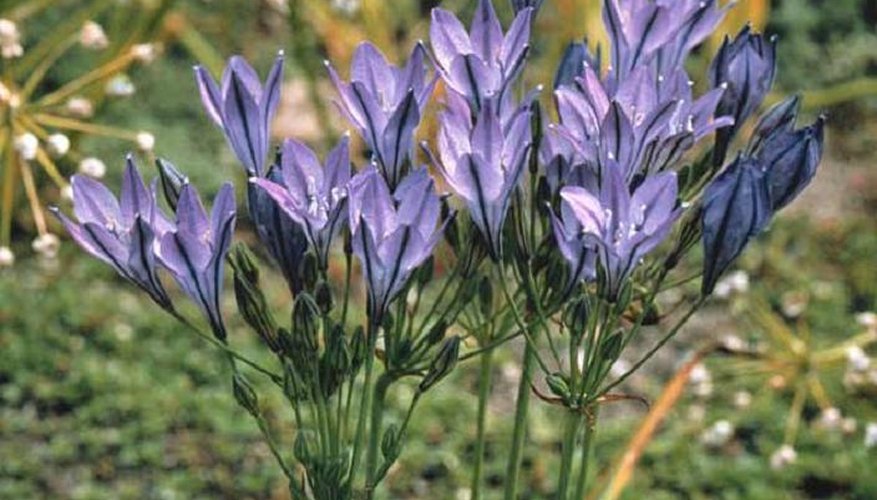Brodiaea "Queen Fabiola" is a late-spring bloomer. Grown from perennial bulbs or "corms," Queen Fabiola produces violet-blue, star-shaped blooms that complement 45 cm (18 inch), deep-green, leafless plant stems. Brodiaea "Queen Fabiola" bulbs are hardy and can survive harsh winters with the help of a mulch blanket. Gardeners who consider planting Queen Fabiola in their landscape must do so in the early spring, just after the final winter frost.
- Brodiaea "Queen Fabiola" is a late-spring bloomer.
- Brodiaea "Queen Fabiola" bulbs are hardy and can survive harsh winters with the help of a mulch blanket.
Prepare a site for the brodiaea that contains well-drained soil and at least six to eight hours of full sun each day. Loosen the soil with a pitchfork, and test the soil pH with a soil testing kit. A pH of 6.5 to 7.0 is favourable for Queen Fabiola bulbs. A soil pH out of this range requires amending.
Amend the soil if the test kit reveals a pH above or below the required levels. Agricultural lime will help raise a pH that is below 6.5, while adding peat moss to the soil will lower any pH over 7.0. The amendment packaging label contains the manufacturer's application instructions.
Dig 12.5 cm (5 inch) holes for the corms using a small trowel. Space each of the holes 7.5 to 12.5 cm (3 to 5 inches) apart. Deposit one Brodiaea 'Queen Fabiola' bulb in each hole, bud side up. Lightly pat the soil over the bulbs.
- Amend the soil if the test kit reveals a pH above or below the required levels.
- Dig 12.5 cm (5 inch) holes for the corms using a small trowel.
Spread a 7.5 to 10 cm (3 to 4 inch) layer of mulch over the bulbs. When the corms sprout, they will work their way through the soil and the mulch, too. Mulching with a layer of bark chips will keep weeds at bay, improve drainage, and keep the bulbs warm when winter comes.
- Spread a 7.5 to 10 cm (3 to 4 inch) layer of mulch over the bulbs.
- Mulching with a layer of bark chips will keep weeds at bay, improve drainage, and keep the bulbs warm when winter comes.
Water the soil lightly, soaking the top layer of soil on a weekly basis until you begin to see green shoots. Once the corms sprout, begin providing weekly supplemental watering with a garden hose at a rate of 2.5 cm (1 inch) of water per week, keeping the soil moist to a depth of 1 inch at all times. Cease watering when the blooms die.
Fertilise the Queen Fabiola once a month. An all-purpose, balanced fertiliser works best for brodiaea. Apply the fertiliser according to the directions on the package, always making sure the soil is moist beforehand.
TIP
Perennial bulbs die back in the autumn and re-emerge in spring -- Brodiaea 'Queen Fabiola' is no exception. You can help redirect energy to the bulb and encourage an increased blooming the following spring by cutting the plants to the soil line after the first frost.
WARNING
Do not overwater the bulbs. Too much water will rot the bulbs before they get a chance to sprout. If the top layer of soil is moist, do not add more water. Once the green stems of the brodiaea appear, press a finger into the soil before each watering. If it feels moist 2.5 cm (1 inch) down, no more water is needed.
